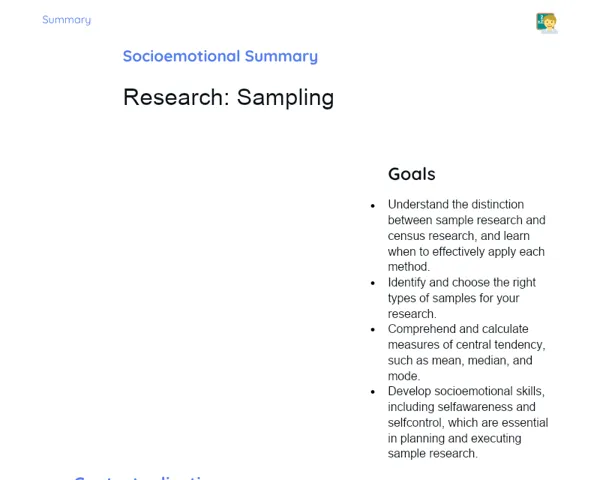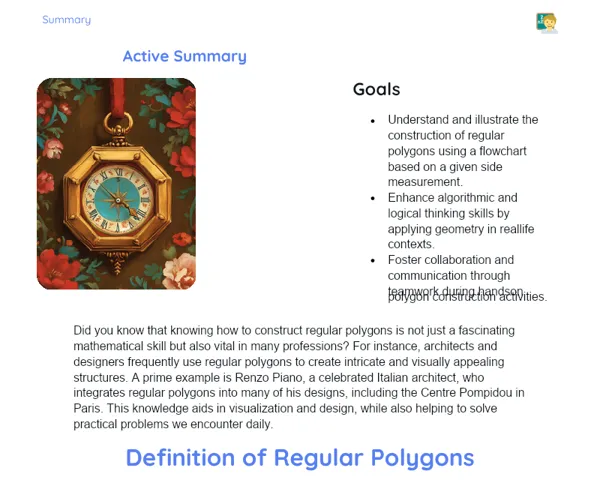Socioemotional Summary Conclusion
Goals
1. Compare the perimeter and area of a regular polygon to grasp the mathematical connection between these measurements.
2. Observe how the perimeter and area of a regular polygon change as the side length varies, grasping concepts of proportionality and scaling.
Contextualization
Have you ever noticed how mathematics sneaks into our daily lives? Think about planning a new garden layout or rearranging your bedroom! 🏡🛏️ To do this effectively, it's crucial to understand the relationship between perimeter and area, enabling you to optimize space and materials. This lesson will highlight the significance of these concepts and how you can apply them practically. Ready to dive in? 🚀
Exercising Your Knowledge
Perimeter
The perimeter is the total length around a geometric figure. For regular polygons, where all sides are identical, it's easy to calculate the perimeter. For instance, for a square, multiply the length of one side by four.
-
Formula: For a regular polygon with n sides of length L, the perimeter P is given by P = n × L.
-
Relevance: Knowing how to determine the perimeter is useful in everyday life, such as measuring lengths for borders, frames, and pathways.
-
Practical Example: If you are fencing a square plot of land with sides of 5 meters, you will need 20 meters of fencing (5m × 4 sides).
Area
The area refers to the measurement of the space inside a geometric figure. Regular polygons have specific formulas to calculate area based on their type. For example, in a square, the area is found by squaring the length of one side.
-
Formula: For a square with sides of length L, the area A is A = L × L or A = L².
-
Relevance: Knowing the area is vital for understanding space requirements, like planning where to place furniture or how much paint is needed for a wall.
-
Practical Example: If you want to carpet a square room of 4 meters on each side, you'll need 16 square meters of carpet (4m × 4m).
Proportionality and Scales
Proportionality refers to the consistent relationship between two or more quantities. In perimeter and area, this means understanding how changes in a side’s length impact both measurements. Scaling helps in enlarging or reducing figures while keeping their proportions intact.
-
Relationship: Altering the side lengths of a regular polygon affects the perimeter and area differently. For example, doubling the side lengths of a square doubles the perimeter, but quadruples the area.
-
Visualization: Creating graphical representations of these changes can clarify the connection between perimeter and area.
-
Practical Application: Comprehending proportionality is essential in fields like engineering and architecture, where precise measurements and proportions are critical.
Key Terms
-
Perimeter: The sum of the lengths of the sides of a geometric figure.
-
Area: The measurement of the internal surface of a geometric figure.
-
Regular Polygons: Geometric figures with all sides and angles equal.
-
Proportionality: A constant relationship between two or more quantities.
-
Scales: Relationships that help enlarge or reduce figures while maintaining their original proportions.
For Reflection
-
How can understanding the link between perimeter and area enable you to make better decisions in personal or academic projects?
-
What feelings did you experience while calculating perimeter and area? How did you navigate these emotions, and what strategies did you employ to overcome any challenges?
-
In what ways are skills like attention to detail, critical thinking, and problem-solving valuable beyond math, enhancing your daily life? How could you apply these skills in other aspects of your life?
Important Conclusions
-
Perimeter is the total length around a geometric figure, essential for measuring lengths of fences, frames, and pathways.
-
Area measures the internal surface of a figure, fundamental for knowing how much space is available or needed, such as in furniture arrangement or paint requirement.
-
Proportionality illustrates how variations in the lengths of polygon sides affect perimeter and area in different ways.
-
Grasping the connection between perimeter and area assists in making informed choices in personal and school projects.
Impacts on Society
In today’s context, understanding perimeter and area is crucial in various domains, including engineering, architecture, and urban planning. Just imagine creating buildings and public spaces without this knowledge! Every space should be optimized for practical use and resource conservation. Additionally, even simple tasks like computing the amount of paint required for a room or flooring necessary for an area incorporate these mathematical concepts.
Emotionally, mastering these topics can enhance students' confidence in their problem-solving and decision-making skills. It's gratifying to apply math in real-life scenarios, fostering a sense of competence and independence. This boosted self-assurance can ripple into other life areas, proving that with dedication and practice, even complex problems can be tackled efficiently.
Dealing with Emotions
To manage your emotions during the study of perimeter and area more effectively, try the RULER method. Start by recognizing your emotions during your studies—whether they're feelings of frustration or joy. Understand the triggers for those emotions; perhaps it's the challenge of a problem or the satisfaction of solving it. Capture the feeling accurately, whether it’s anxiety, excitement, or something else. Share your feelings with classmates or maintain a journal to express yourself. Lastly, regulate your emotions through breathing exercises or taking well-timed breaks to stay calm and motivated.
Study Tips
-
Create vibrant graphs and diagrams to visualize the relationship between perimeter and area. This makes the learning experience much more intuitive!
-
Engage in hands-on projects, such as planning spaces at home or school using the concepts learned. Practice makes understanding more meaningful!
-
Form study groups with classmates to discuss doubts and exchange problem-solving strategies. Collaboration can enhance your understanding and make studying more enjoyable!



